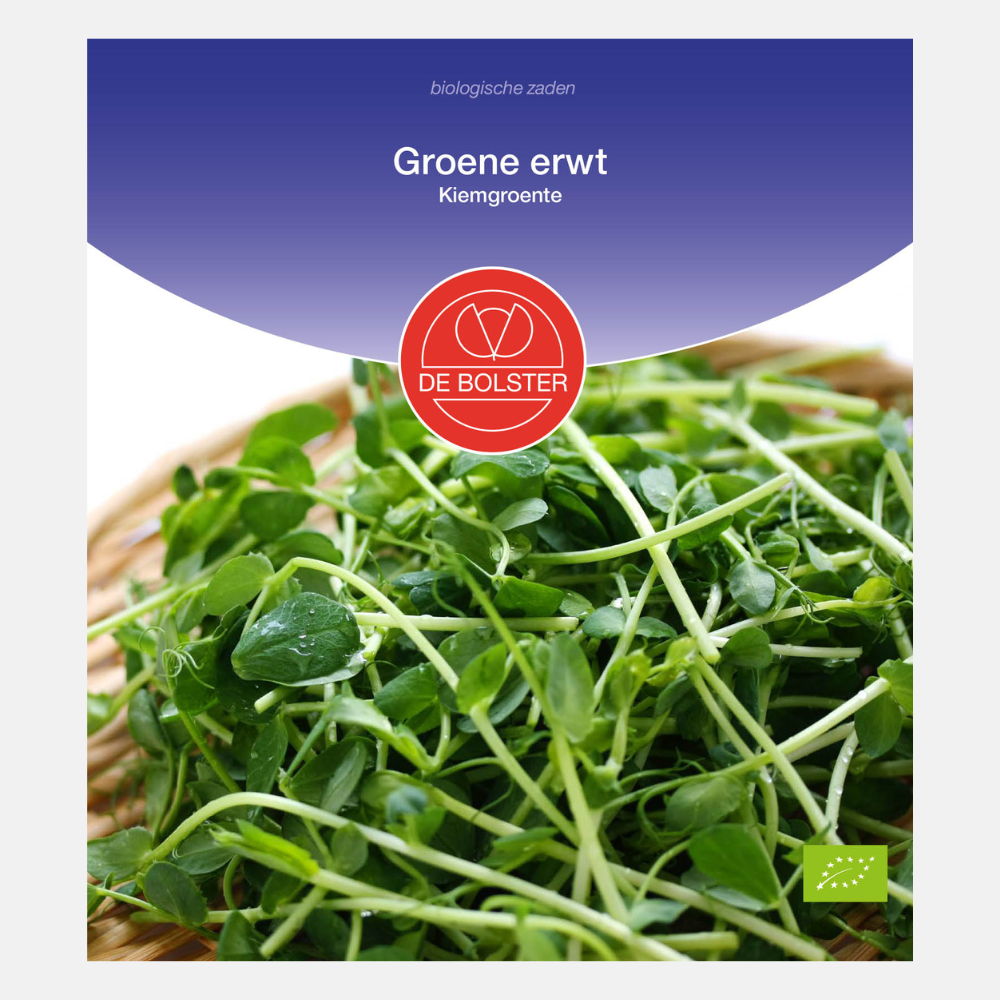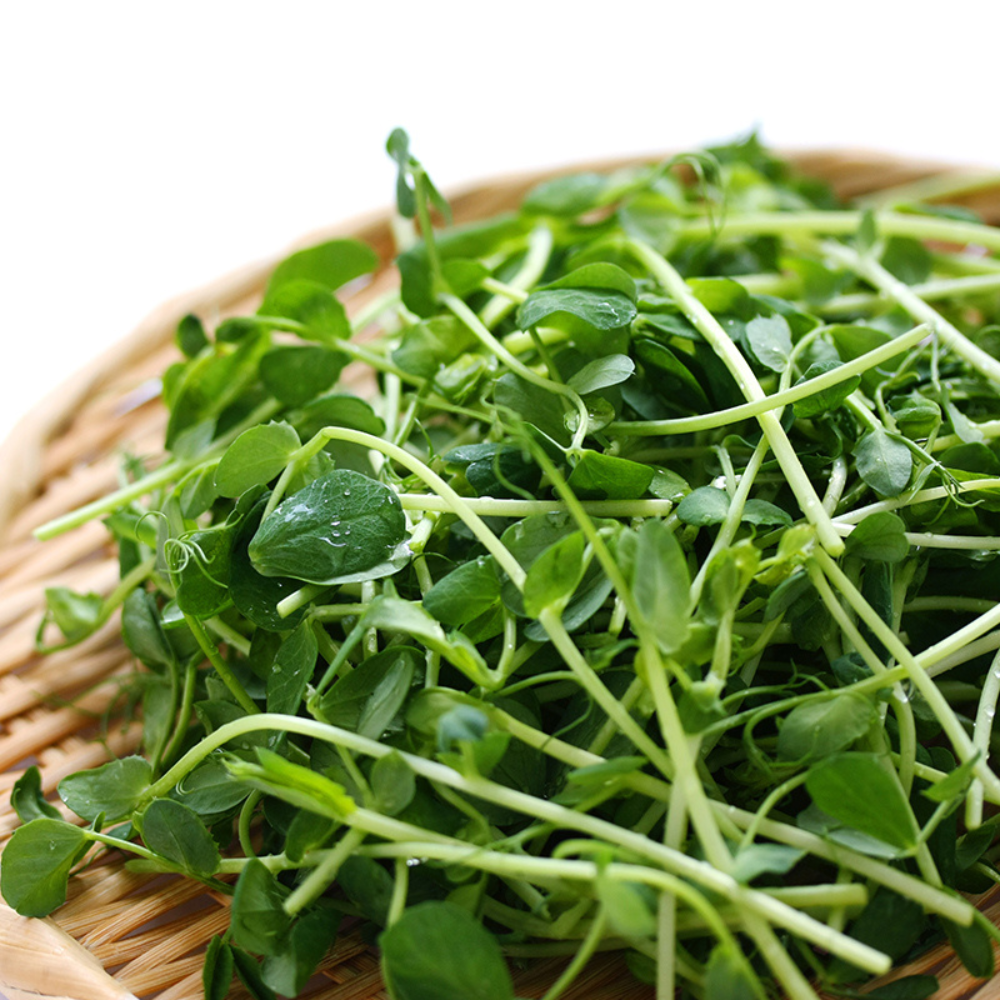Green pea - Sprouts BIO
Green pea sprouts are delicious as a snack, but also in salad or soup. These sprouts have a sweet taste. They can be harvested after about 9 to 11 days. The shoots are then 9 to 12 cm high.
Green pea as sprout vegetable is deliciously sweet and is often used as decoration of salads. Also delicious as a snack, on bread, in salad, in soup, stew or other warm dishes.
Instructions for use
Fill the germination tray with tap water to just above the grid. Sprinkle the peas evenly on the grid. The peas may lie in the water a little, because they absorb a lot of water. They will grow one and a half times as big. So make sure there is enough space between them when sowing.
Place the germination tray at room temperature, in a light spot, but not in full sun.
Check the water level daily and top up to the grid if necessary. As long as the peas do not have sprouts, they should remain moist, but not soaked.
After two days, the peas will be attached to the grid with their germ roots and you can change the cloudy water.
Keep checking the water level daily. The seedling roots should be in the water, but keep the seedlings dry. This reduces the chance of problems with mold.
After 9 to 11 days the seedlings are 9 to 12 cm long and can be harvested. Cut them off with scissors just above the grid.
- Biologisch
- Yes
- Merk
- The Bolster
- Type en soort
- Open-pollinated variety
- Standplaats
- Sun Partial shade
- Zaaien
- January February March April May June July August September October November December
- Planttijd
- January February March April May June July August September October November December
- Hoogte
- 12 cm
- Inhoud
- Approx. 275 seeds
Green pea - Sprouts BIO is backordered and will ship as soon as it is back in stock.
Couldn't load pickup availability
Dispatch
Dispatch
We ship your order within 1-2 business days*. When you spend €75,- you get one free shipment. Shipping is possible from €3.95. All orders are shipped as a package with a track and trace code, so you can always follow your order. Read more about the shipping costs in our FAQ.
Delivery time pre-order
Your order will be shipped from the indicated availability date. This also applies if you combine pre-order with products that are already in stock.
*Please note: In some cases this is not the case, such as: pre-orders, chicory roots, trees and small fruit. Read more in our FAQ.
The Bolster
The Bolster
Pioneer in organic seeds
De Bolster has been the specialist in 100% organic seeds for 45 years, with a focus on sustainability and future-proof agriculture. They produce seeds of more than 330 varieties, from vegetables and flowers to green manures, at international locations and completely GMO-free. With organic breeding methods and a commitment to variety freedom, they work together with professional growers and hobby gardeners to make organic cultivation accessible to everyone. Since 2023, they have been operating as a cooperative, to increase the impact of organic farming together with customers and suppliers. Their dream? A healthy planet with 100% organic farming.
Explanation of resistances
Explanation of resistances
Our seeds are provided with different resistance codes. In this PDF you will find a clear explanation of all codes and their meaning.
Different types of seeds
Different types of seeds
What is the difference between organic, F1 hybrid, heirloom (open-pollinated), GMO, pill and conventional seeds? We explain it to you in this blog !
Saving seeds
Saving seeds
Store seeds in a cool, dry and dark place, such as a sealed box in a cupboard. Pay attention to the expiration date on the packaging and use them before that time. If the packaging has been opened, make sure it is sealed properly and check the germination capacity before use.
You can easily test the germination capacity of seeds with a germination test :
- Place a few seeds (for example 10) on a damp piece of kitchen paper.
- Fold the paper towel closed and place it in a plastic bag or place it in a sealed container.
- Place it in a warm place, such as on the windowsill.
- After a few days, check to see if the seeds have started to germinate.
Basic sowing guide
Basic sowing guide
First time sowing? No problem! Our basic sowing guide will briefly explain how to get started. Also take a look at our extensive growing guides for specific tips per plant species - super handy if you want to know exactly how to grow aubergine or garlic, for example 🌱.








